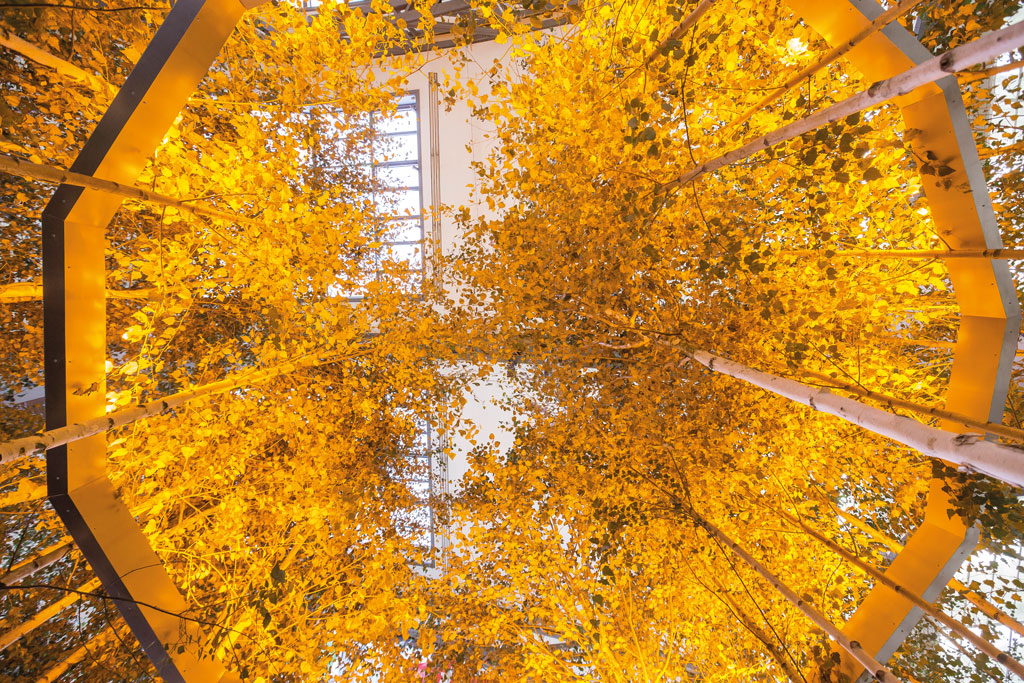ART-PRESENTATION: Olafur Eliasson-Y/Our Future Is Now
 Olafur Eliasson’s work is driven by his interests in perception, movement, embodied experience, and feelings of self. He strives to make the concerns of art relevant to society at large. Art, for him, is a crucial means for turning thinking into doing in the world. Eliasson’s works span sculpture, painting, photography, film, and installation. Not limited to the confines of the museum and gallery, his practice engages the broader public sphere through architectural projects, interventions in civic space, arts education, policy-making, and issues of sustainability and climate change.
Olafur Eliasson’s work is driven by his interests in perception, movement, embodied experience, and feelings of self. He strives to make the concerns of art relevant to society at large. Art, for him, is a crucial means for turning thinking into doing in the world. Eliasson’s works span sculpture, painting, photography, film, and installation. Not limited to the confines of the museum and gallery, his practice engages the broader public sphere through architectural projects, interventions in civic space, arts education, policy-making, and issues of sustainability and climate change.
By Dimitris Lempesis
Photo: Serralves Museum Archive
Olafur Eliasson’s solo exhibition “Y/Our Future Is Now” is inspired by natural phenomena and are placed throughout the Serralves Museum atrium, the central gallery of the Siza building, and the surrounding parkland. Works include “Yellow forest” (2017) a circular group of birch trees lit by a ring of yellow monofrequency lamps that challenges perceptions of the natural and the artificial; a large pavilion, “The curious vortex” (2019) which swirls in the shape of a vortex; and three new sculptures, “Human time is movement (winter, spring, summer)” (2019) a series of black-and-white stainless-steel spirals that were made especially for the exhibition. In the museum’s central atrium, visitors are invited to walk along a path defined by “Yellow forest” (2017), a work originally conceived in collaboration with landscape architect Günther Vogt. It consists of an artificial forest formed by two groups of birch trees that occupy and redefine the architectural space. Within this circular forest, the light cast by a ring of yellow monofrequency lamps alters visitors’ chromatic perceptions, making them see all colours as shades of grey, yellow, or black. The interference in the viewer’s perception processes, through spatial, chromatic and luminous deconstruction, refers to the idea that the forest is a dreamlike place, a space of connection between humans and the earth. At the same time, the work is a living organism, in a state of constant change. Humankind’s relationship with the surrounding environment is also addressed in “The listening dimension (orbit 1, orbit 2, orbit 3)” (2017) presented in the museum’s central gallery. When entering this space, the visitor encounters wall-sized mirrors and large rings that appear to float in space. Seemingly defying the laws of physics and optics, these works produce a destabilizing and disturbing effect. The repetition of the elements via the reflective surfaces expands the room’s size and absorbs each visitor, whose individual interaction with the work is fundamental, because his or her movements influence the way that the entire work is understood and experienced. The carefully fabricated effect casts doubt on our linear perception of space, the boundary between reality and representation, the relationship between knowledge and the experience of the visible. This installation opens a dialogue between the exhibition and the sculptures installed in the park. In the roundabout on the Liquidâmbares, “The curious vortex” (2019) is linked to Eliasson’s research on geometry and the construction of spaces and creation of environments, as well as his social and cultural reflections. The large, stainless-steel pavilion’s shape is inspired by the swirling movements of a vortex, a natural phenomenon created by a spinning mass of wind and water. The artist relates this phenomenon to the work of museum institutions in contemporary society: just as the force of a whirlwind develops around a rotating centre, museums also have the ability to channel thoughts, ideas, feelings, affections. This work invites visitors to think about their relationship with the multiple potentialities of the museum and the world itself – the fact that everything is in perpetual motion, in permanent change. The placement of this work in an outdoor space, exposed to the elements and the cycle of day and night, highlights the relation between the observer, movement, change and temporality. In the Yew Glade we find the works “Human time is movement (winter, spring, summer)” (2019). Mathematics is the basis for the design of these three black-and-white stainless-steel spirals, which form lines that develop in space as if they were three-dimensional drawings. Variations on a Clelia curve, a line created by tracing a point as it moves along two axes of a sphere simultaneously, the strikingly different forms communicate the passage of time as embodied by movement. Returning to a typology of works already presented in other contexts, Eliasson distributed driftwood logs, for the artwork “Arctic tree horizon” (2019) in the park around the museum building as if the driftwood logs had washed ashore there. Iceland has few trees, and no forests, but plentiful logs can be found along the country’s coasts, where they have been transported from Siberia by sea currents and drifting polar ice. Eliasson collects these logs, salted by the ocean and bleached by the sun, and redistributes them in foreign locations that lend them new meaning. For this exhibition, the artist coated the wood with black paint that suggests tar – a material formerly used for sealing ships against seawater – creating landmarks in the landscape that evoke thoughts about migration, circulation, and the larger ecological system we inhabit.
Info: Curators: Philippe Vergne, Marta Moreira de Almeida, and Filipa Loureiro, Serralves Contemporary Art Museum, Rua D. João de Castro 210, Porto, Duration: 31/7/19-8/3/20, Days & Hours Mon-Fri 10:00-19:00, Sat-Sun 10:00-20:00 & Serralves Park, Rua D. João de Castro 210, Porto, Duration: 31/7/19-14/6/20, Days & Hours Mon-Fri 10:00-19:00, Sat-Sun 10:00-20:00, www.serralves.pt
